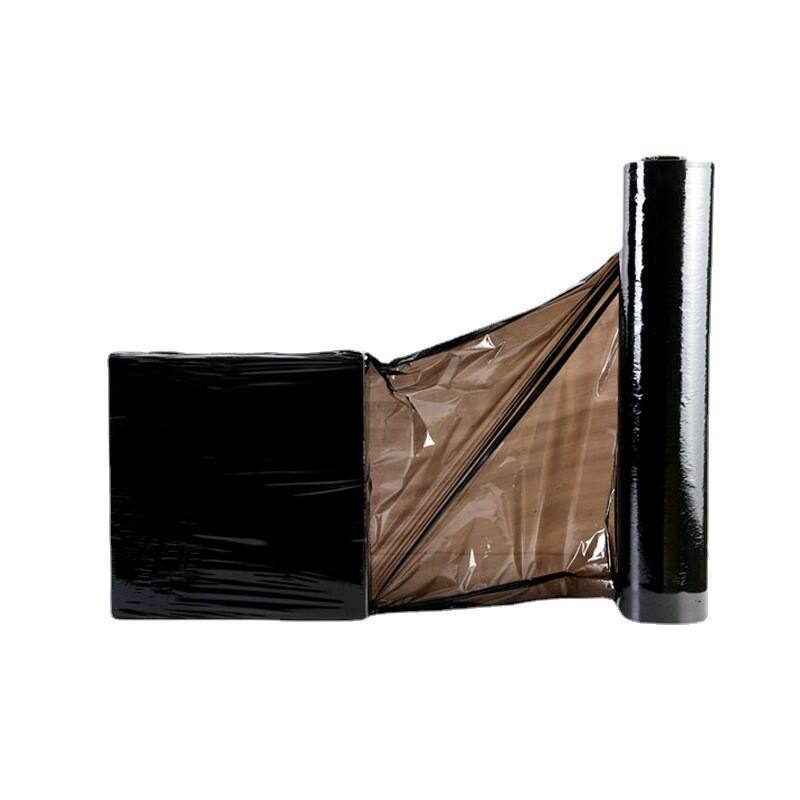Stretch films play a critical role in packaging, but their performance varies significantly depending on whether they are bio-based or fossil-based. These differences in performance stem from factors like strength, durability, elasticity, environmental impact, and cost-effectiveness. Bio-based films often prioritize sustainability, while fossil-based options focus on proven reliability. Understanding these distinctions helps businesses and consumers make informed choices that align with their priorities, whether they value environmental benefits or superior material performance.
Differences in Performance: Strength and Durability
Tensile Strength
Tensile strength measures a material's ability to withstand pulling forces without breaking. Fossil-based stretch films typically exhibit higher tensile strength due to decades of refinement in their production processes. These films often rely on petroleum-derived polymers, which provide consistent and robust performance under stress. This makes them suitable for heavy-duty applications, such as securing industrial goods during transportation.
Bio-based stretch films, on the other hand, show varying levels of tensile strength depending on the materials used. For instance, bio-based polyethylene derived from renewable resources like bio-naphtha can achieve comparable strength to fossil-based alternatives when manufactured with advanced techniques. However, some bio-based polymers, such as polylactic acid (PLA), may fall short in tensile strength, limiting their use in demanding packaging scenarios. Despite these challenges, ongoing innovations in bio-based film production aim to close the gap in performance.
Resistance to Wear and Tear
Resistance to wear and tear determines how well a material can endure repeated use or exposure to external forces without degrading. Fossil-based stretch films excel in this area due to their inherent durability and resilience. These films resist punctures, abrasions, and environmental factors like moisture, ensuring reliable performance over extended periods.
Bio-based stretch films, while improving in durability, often face limitations in this aspect. Some bio-based materials may exhibit lower resistance to punctures or abrasions, especially when subjected to harsh conditions. However, certain bio-based films, such as those designed for flexible food packaging, demonstrate high tear resistance, making them suitable for specific applications. Manufacturers continue to explore innovative formulations to enhance the durability of bio-based films, aiming to match or exceed the performance of their fossil-based counterparts.
"The differences in performance between bio-based and fossil-based stretch films highlight the trade-offs between sustainability and material reliability," as noted by industry experts. Businesses must evaluate their specific needs to determine which type of film aligns best with their operational requirements.
Differences in Performance: Elasticity and Stretchability
Stretching Capabilities
Stretching capabilities define how far a material can extend without breaking. Fossil-based stretch films excel in this area due to their well-established polymer structures. These films can stretch significantly, making them ideal for applications requiring high flexibility and adaptability. Their ability to elongate ensures secure wrapping of irregularly shaped items, reducing the risk of damage during transportation.
Bio-based stretch films, while improving, often display varied stretching capabilities. Some bio-based materials, such as those derived from polylactic acid (PLA), may have limited extensibility compared to fossil-based options. However, advancements in bio-based polyethylene production have enabled certain films to achieve comparable stretching performance. Manufacturers continue to refine these materials to enhance their usability in demanding packaging scenarios.
Recovery and Retention
Recovery and retention refer to a material's ability to return to its original shape after being stretched and maintain its hold over time. Fossil-based stretch films demonstrate superior recovery due to their elastic properties. These films effectively cling to packaged goods, ensuring stability and minimizing the need for additional securing measures. Their retention capabilities make them a reliable choice for long-term storage and transportation.
Bio-based stretch films, on the other hand, often face challenges in achieving the same level of recovery and retention. Some bio-based polymers may struggle to maintain their elasticity after repeated use, which can compromise their effectiveness in securing loads. Despite these limitations, certain bio-based films have shown promise in specific applications, such as food packaging, where moderate recovery and retention are sufficient. Ongoing research aims to bridge the differences in performance between bio-based and fossil-based films in this critical area.
"Elasticity and stretchability are key factors in determining the suitability of stretch films for various applications," according to industry analysts. Businesses must weigh these attributes alongside other considerations, such as environmental impact and cost, to select the most appropriate material for their needs.
Differences in Performance: Environmental Impact
Production Process
The production process significantly influences the environmental impact of stretch films. Fossil-based stretch films rely on petroleum extraction and refining, which contribute to greenhouse gas emissions and resource depletion. These processes often involve energy-intensive operations that leave a substantial carbon footprint. Additionally, the chemical additives used in fossil-based film production can pose risks to ecosystems if not managed properly.
Bio-based stretch films, in contrast, utilize renewable resources such as plant-based materials like bio-naphtha or polylactic acid (PLA). These materials reduce dependency on finite fossil fuels and often result in lower carbon emissions during production. For instance, bio-based polyethylene derived from agricultural byproducts can achieve a more sustainable lifecycle. However, the cultivation of raw materials for bio-based films may require significant land, water, and energy resources, potentially offsetting some of their environmental benefits. Manufacturers must carefully balance these factors to optimize sustainability.
"The differences in performance between bio-based and fossil-based stretch films extend beyond material properties to include their environmental impact," as noted by sustainability experts. Businesses should evaluate the production methods to align with their ecological goals.
End-of-Life Considerations
End-of-life management plays a critical role in determining the overall environmental impact of stretch films. Fossil-based films, composed of non-biodegradable polymers, often end up in landfills or incinerators. These disposal methods contribute to long-term pollution and release harmful emissions. Recycling options exist for fossil-based films, but contamination and limited recycling infrastructure can hinder their effectiveness.
Bio-based stretch films offer more environmentally friendly end-of-life options. Many bio-based materials, such as PLA, are biodegradable or compostable under specific conditions. This feature reduces the accumulation of plastic waste in landfills and minimizes environmental harm. However, proper disposal infrastructure is essential to realize these benefits. Without industrial composting facilities, bio-based films may not degrade effectively, leading to similar challenges as fossil-based alternatives.
To maximize sustainability, both industries must invest in improved recycling technologies and waste management systems. Educating consumers and businesses about proper disposal methods can further enhance the environmental performance of stretch films.
Differences in Performance: Cost-Effectiveness
Initial Costs
Initial costs often play a significant role in determining the feasibility of adopting a particular type of stretch film. Fossil-based stretch films generally have lower upfront costs due to their established production processes and widespread availability. Manufacturers have optimized these processes over decades, resulting in economies of scale that reduce production expenses. This affordability makes fossil-based films an attractive option for businesses seeking cost-effective solutions for large-scale packaging needs.
Bio-based stretch films, however, tend to have higher initial costs. The production of bio-based materials involves newer technologies and renewable resources, which can increase manufacturing expenses. Additionally, the cultivation and processing of raw materials, such as bio-naphtha or polylactic acid (PLA), require significant investment. These factors contribute to the higher price point of bio-based films compared to their fossil-based counterparts. Despite this, businesses with sustainability goals may view the higher initial costs as a worthwhile trade-off for reducing their environmental footprint.
Long-Term Value
Long-term value encompasses factors such as durability, performance consistency, and environmental benefits over time. Fossil-based stretch films often provide reliable long-term performance due to their proven strength, elasticity, and resistance to wear and tear. Their durability reduces the need for frequent replacements, which can lower overall costs in the long run. However, their environmental impact, including challenges with recycling and disposal, may lead to additional expenses related to waste management or compliance with environmental regulations.
Bio-based stretch films offer unique advantages in terms of long-term value, particularly for businesses prioritizing sustainability. Many bio-based materials, such as PLA, are biodegradable or compostable, which can reduce waste management costs and align with eco-friendly practices. Additionally, advancements in bio-based film technology continue to improve their performance and durability, narrowing the gap with fossil-based alternatives. While the initial investment may be higher, the potential for reduced environmental impact and alignment with consumer demand for sustainable products can enhance the long-term value of bio-based films.
"The differences in performance between bio-based and fossil-based stretch films extend beyond material properties to include cost-effectiveness," as noted by industry professionals. Businesses must weigh both short-term expenses and long-term benefits when selecting the most suitable stretch film for their operations.
The differences in performance between bio-based and fossil-based stretch films reveal distinct advantages and limitations. Fossil-based films excel in strength, elasticity, and cost-effectiveness, while bio-based options prioritize sustainability and environmental benefits. Businesses must weigh these trade-offs carefully. For operations requiring durability and proven reliability, fossil-based films remain a strong choice. However, companies with environmental priorities may find bio-based films more suitable, especially as advancements continue to improve their performance. Selecting the right stretch film depends on aligning material properties with specific operational needs and long-term goals.


